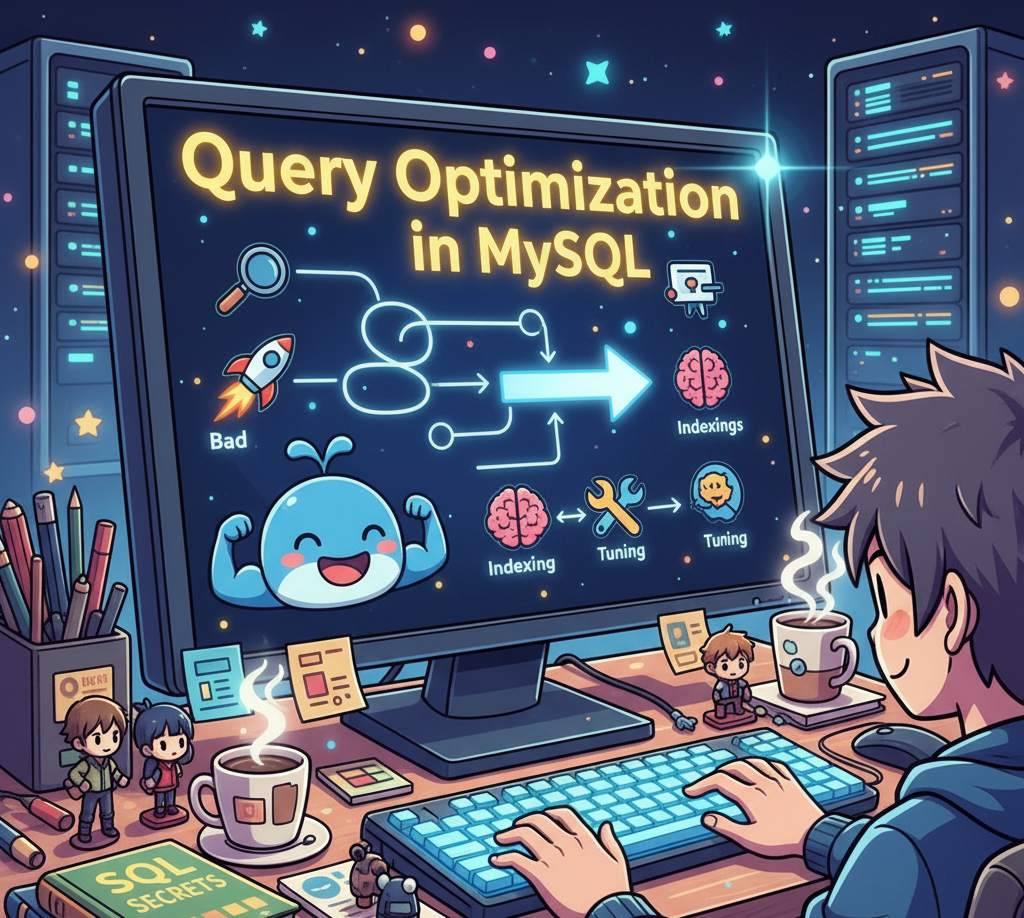Optimizing MySQL queries requires both fundamental techniques (like indexing and query rewriting) and advanced strategies (like configuration tuning and caching). Continuous monitoring ensures sustained performance. Even applying a single method, such as running EXPLAIN on your slowest query, can produce measurable improvements and long-term scalability.
The Role of Query Optimization in Modern Applications
Query optimization in MySQL is essential for modern systems that face rapid data growth and demand consistently low response times. Poorly written queries can strain computational resources, inflate operational costs, and hinder scalability. By mastering optimization techniques, administrators and developers can achieve smoother performance, greater efficiency, and sustained growth without immediately resorting to hardware upgrades.
Fundamentals of Query Optimization
Optimization involves strategically adjusting SQL statements and server configurations to reduce execution time and resource consumption. MySQL’s internal optimizer determines execution paths, but administrators must analyze them critically.
The EXPLAIN statement is an indispensable tool for visualizing query execution. For example:
EXPLAIN SELECT * FROM users WHERE age > 30;
This reveals whether MySQL performs a costly full table scan or efficiently leverages indexes. Key output metrics — such as access type, key usage, and row estimates — highlight areas requiring refinement.
Impact on Performance and Operational Efficiency
Fast query execution reduces CPU load and disk I/O, enabling systems to support more users with fewer resources. Conversely, slow queries degrade overall responsiveness. Optimized databases can cut response times by half, directly improving user retention and business outcomes.
Identifying Performance Bottlenecks
To track issues, administrators should enable the slow query log:
slow_query_log = 1
This records queries exceeding a set threshold (e.g., 2 seconds). For deeper analysis of lock waits and system events, the Performance Schema should be enabled:
performance_schema = 1
Refuting Common Misconceptions
- Indexes are not always beneficial. While indexes speed retrieval, excessive indexing slows down writes such as INSERT or UPDATE operations.
- Complex queries can often be simplified. Rewriting subqueries into joins frequently improves performance.
- Hardware is not a cure-all. While faster servers help, efficient query design delivers greater long-term gains.
Foundational Optimization Techniques
The EXPLAIN Statement
Running EXPLAIN before a query outlines how MySQL executes it. For example:
EXPLAIN SELECT name FROM customers WHERE country = 'PH';
Key output values:
- Type – Access method (e.g., index, full scan).
- Rows – Estimated number of rows scanned.
High row counts usually suggest a missing or poorly defined index.
Indexing Strategies
Indexes act as accelerators for data retrieval. Examples:
- B-Tree index:
CREATE INDEX idx_age ON users(age); - Full-Text index:
CREATE FULLTEXT INDEX idx_content ON articles(content);
Indexes must be managed carefully to avoid slowing down writes. Regularly remove unused indexes and benchmark insert/update times after changes.
Query Structure Refinement
Best practices include:
- Selecting only required columns instead of
SELECT *. - Using
LIMITto reduce unnecessary data retrieval. - Converting subqueries into joins for efficiency.
Instead of:
SELECT * FROM orders WHERE customer_id IN (SELECT id FROM customers);
Use:
SELECT o.* FROM orders o JOIN customers c ON o.customer_id = c.id;
Advanced Performance Tuning and Scalability
Configuration Management
Performance tuning often starts with my.cnf. Key parameter:
innodb_buffer_pool_size = 8G
(approximately half of system RAM, adjusted per workload).
Note: The query cache was removed in MySQL 8.0. For older versions, disable or carefully manage it. Tools like mysqltuner can recommend adjustments.
Efficient Join Handling
- Use INNER JOIN when null rows are unnecessary.
- Favor EXISTS over IN for large lists.
For runtime diagnostics, MySQL 8.0 introduced EXPLAIN ANALYZE:
EXPLAIN ANALYZE SELECT * FROM a JOIN b ON a.id = b.a_id;
External Caching Implementation
With MySQL’s query cache deprecated, external caches (e.g., Redis) or application-level caching are essential. High-traffic sites can reduce database load by 70% using caching plus indexing.
Continuous Performance Monitoring and Maintenance
Diagnostic Tools
SHOW PROCESSLIST;– Displays running queries.KILL [process_id];– Terminates problematic queries.- Performance Schema tables (e.g., events_statements_summary) reveal trends in query performance.
Benchmarking and Profiling
- mysqlslap:
mysqlslap --concurrency=10 --iterations=100 --query="SELECT * FROM users;" - pt-query-digest: Analyzes slow logs and ranks expensive queries.
Ongoing Maintenance
- Run
ANALYZE TABLEregularly. - Upgrade MySQL versions to benefit from performance fixes.
- Use tools like pt-online-schema-change for live schema modifications without downtime.
Bringing It All Together
Optimizing MySQL queries requires both fundamental techniques (like indexing and query rewriting) and advanced strategies (like configuration tuning and caching). Continuous monitoring ensures sustained performance. Even applying a single method, such as running EXPLAIN on your slowest query, can produce measurable improvements and long-term scalability.
References
- Oracle. MySQL 8.0 Reference Manual: Optimization Overview. https://dev.mysql.com/doc/refman/8.0/en/optimization.html
- Baron Schwartz, Peter Zaitsev, Vadim Tkachenko. High Performance MySQL, 3rd Edition. O’Reilly Media, 2012.
- Percona Toolkit Documentation. https://www.percona.com/doc/percona-toolkit/
- Redis Documentation. https://redis.io/docs/

